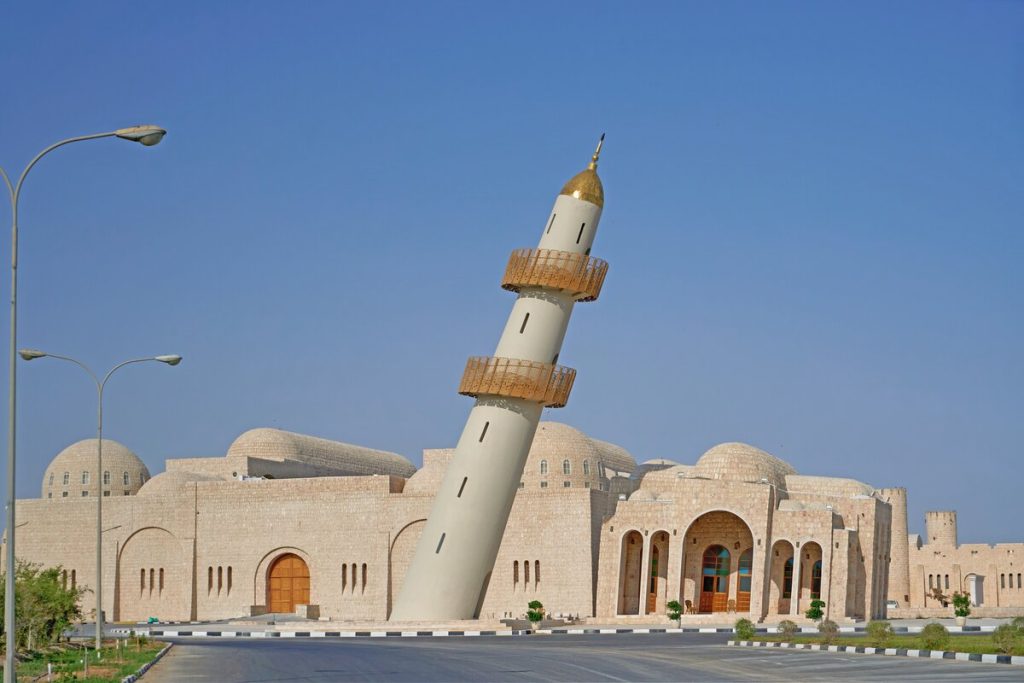There are numerous mosques in Qatar, some of which are very old, that are still used for daily prayer by local Muslims. There are over 2,000 mosques across Qatar, mostly managed by the Ministry of Awqaf and Islamic Affairs and some by Qatar Museums (QM).
Non‑Muslims are able to enter most mosques, except for the Shioukh Mosque next to the Amiri Diwan. Entry to all mosques is free of charge. It is best to visit mosques outside of prayer times.
Mosque etiquette
Sheikh Abdulla Bin Zaid Al Mahmoud Islamic Cultural Center (Fanar) organises tours of its own mosque near Souq Waqif, and those at Katara Cultural Village and Education City. Visitors must remember to dress appropriately: no shorts, short skirts or dresses, sleeveless tops or other revealing garments. Women will be asked to wear an abaya and to cover their hair. In some mosques, abayas and scarves are provided.
Abu Manaratain Mosque
Located in the southern town of Al Wakra, the Abu Manaratain Mosque was built in 1940 and restored in 2004. This unusual mosque lacks the high walls typical of Qatari mosques and can only be visited externally. Even though manaratain means ‘two minarets’ in Arabic, this mosque only has one tall, slender tower.
Al-Mujadilah Center and Mosque for Women
Al-Mujadilah is a centre and mosque that offers religious, developmental and social programming to Muslim women of all ages and backgrounds to study, dialogue and worship together. It is equipped with classrooms, a library, gathering spaces, a café, and gardens. A community space for women, it hosts activities and provide programming in Arabic and English ranging from courses, workshops, sessions on Islamic history, Islamic law, mental health and wellbeing, and relationships to book clubs, training programmes and undertaking research. Contact: 4454 6685, qf.org.qa
Al Qubib Masjid (pictured above)
Located in Al Souq Area in central Doha, Al Qubib Masjid is one of the oldest mosques in the region. The mosque was built to resemble and replace an older mosque demolished in 1950, and said to be a unique example of multi-dome mosques in the Gulf region. The mosque has now been restored as part of Al Qubib Masjid Plaza development project by Ashghal’s Supervisory Committee of Beautification of Roads and Public Places. The new layout of the mosque closely follows the older mosque, but with modern amenities such as technical rooms, offices, and ablution facilities. The mosque can receive up to 800 worshippers.
Al Ruwais Mosque
Currently under renovation by Qatar Museums (QM), Al Ruwais Mosque is in Al Ruwais, a port town in northern Qatar. Though constructed in 1915, it is thought to have been built on the ruins of an earlier 17th century mosque, making it the first and oldest mosque in Qatar. It has three rectangular galleries linked by doors or a row of seven arches. The furthest gallery contains a deep rectangular, unevenly shaped and underdecorated mihrab, a semicircular niche in the wall of a mosque that indicates the qibla (the direction of the Kaaba in Mecca and the direction Muslims face when praying). A small stone staircase leads to the minbar, the pulpit from which the sermon (khutbah) is delivered, and the final gallery opens directly into the courtyard of the mosque. The tall, octagonal minaret is in the south eastern corner of the courtyard with a roughly square-shaped base, and is crowned with a cone-shaped dome with openings to allow light and air inside. One can enter the minaret via the internal spiral staircase or by ladder.
Aspire Mosque
With 1,460 sq m, accommodating 700 men and 150 women for prayer, Aspire Mosque incorporates the most appropriate form and architectural finishes, falling into harmony with the adjacent buildings.
Education City Mosque
The mosque, a large white cavernous structure with Quranic verses embossed into its large ceiling, is dotted with small lights, and has the capacity to hold approximately 1,800 people in its indoor prayer halls and outdoor courtyard. The main (male) prayer room on the first floor features an in-house library, and a large gilded mihrab in a Quran verse-lined alcove. Upstairs, a female gallery room complete with a separate seating area is sectioned off from the main prayer room by a high wall. The mosque rests on five structural pillars and is decorated with verses. Underneath, water flows from four streams originating from a garden that lines the perimeter of the building. Two tall, slim minarets jutt out of one side of the structure, rising some 90 m in the air in the direction of Mecca. Islamic calligraphy forms the heart of the building, inscribed on almost every element of the structure’s surface, from roofs to ceramic tiles to glass windows. Contact: 4454 6600, qf.org.qa/community/education-city-mosque
Hamad bin Jaber bin Mohamed Al Thani Masjid (Hamad bin Jassim Mosque)
Also known as The Pearl Mosque, the new Hamad bin Jaber bin Mohamed Al Thani Masjid is located in Porto Arabia in The Pearl Island. Infusing Gothic and Islamic architecture, the stunning tall and large scale mosque is 18,100 sq m with stone marble and large stained glass windows. Surrounded by lush greenery and pristine waters, the mosque can accommodate as many as 2,500 worshippers.
Hamad International Airport (HIA) mosque
The public mosque is located just outside the passenger terminal, within walking distance from the Departures hall. The shape of a water droplet inspires the mosque’s architecture, and it offers spectacular views of the lagoon and Amiri Terminal.
 Imam Muhammad Ibn Abdul Wahhab Mosque (The State Mosque)
Imam Muhammad Ibn Abdul Wahhab Mosque (The State Mosque)
Located on Khalifa Street/Onaiza Street, the renamed State Mosque is the largest in Qatar and can accommodate 10,000 worshippers inside and 30,000 outside. Traditional‑style lighting illuminates the outer courtyard, where there is granite seating. The main prayer hall has 28 large domes and a single minaret 65 m high. Structurally inspired by the ‘Bo Al Qabib’ mosque designed by Sheikh Jasim bin Mohammed Al Thani, the founder of modern Qatar. While it is not open to the public, it is a very impressive yet understated piece of architecture and spectacular at night.
Katara Masjid (Blue Mosque)
Located in Katara Cultural Village, the Katara Masjid is one of the most beautiful mosques in the country. Designed by globally-known Turkish mosque designer, Zeynep Fadıllıo lu, and a team of restoration specialists from Dolma Palace in Istanbul, the interior and exterior architectural designs, together with the minaret, the dome, and the prayer niche (mihrab) are all inspired by several famous mosques found in various cities and capitals of the Islamic world.
Msheireb Mosque
Nestled among the traditional houses of Msheireb Museums in the heritage Quarter of Msheireb Downtown Doha sits Msheireb Mosque. The design fuses modernism with a historical arrangement of spaces, using specifically Qatari materials and architectural details. The mosque has been designed to LEED Gold Standard and utilises passive and active sustainable techniques including photovoltaics and solar hot water heaters. The prayer hall is designed so that no artificial lighting is needed during daylight hours. Opened for prayers in 2016, the mosque can accommodate 600 worshippers.
Sheikh Abdulla bin Zaid Al Mahmoud Islamic Cultural Center (Fanar) (pictured above)
The distinctive curled minaret makes Fanar one of Qatar’s most iconic buildings. Opposite Souq Waqif on Grand Hamad Street, the centre offers non‑Muslims the opportunity to learn more about Islam through various activities, including attending Friday prayers, taking a tour of the mosque, learning Arabic or downloading publications from the website. Check their Facebook page for events and schedules. Contact: 4444 7444, binzaid.gov.qa
Sheikh Abdulrahman bin Mohamed Al Abdulrahman Al Thani Mosque
Also known as Al Rayyan Mosque, the Sheikh Abdulrahman bin Mohamed Al Abdulrahman Al Thani Mosque is located opposite the Qatar Racing and Equestrian Club. The mosque is one of the largest mosques in Qatar with sky high minarets of up to 60 m and domes of 39 m, covering an area of over 9,000 sq m. As many as 2,500 worshippers are able to pray in the mosque, with a separate prayer area for women. The mosque also includes small libraries within the walls and pillars of the prayer hall consisting of a large collection of Qurans, and with at least 100 books and religious reading material in various languages.
Sheikh Hamad bin Sultan bin Jassim bin Mohammed Al Thani Mosque
Sheikh Hamad bin Sultan bin Jassim bin Mohammed A Thani Mosque in Umm Al Amad has been reconstructed and reopened in April 2023. Built over 2,267 sq m, the mosque can accommodate 1,150 worshipers. The new mosque has a main prayer hall that can accommodate 650 worshipers, and a prayer hall on the mezzanine floor that can accommodate 450 worshipers, in addition to a women’s hall that can accommodate 60 worshipers, and parking for 17 cars, with several parking lots designated to serve people with special needs.
Simaisma Mosque
North of Doha on Al Khor Coastal Road (Route 6) is Simaisma, a 19th century fishing and pearling town, where the mosque is open from sunrise to late afternoon. Dating back to 1938, it used to house a madrassa (school) teaching the holy Quran to children as well as being a place of prayer. Visitors are advised not to enter the mosque or to take photographs during prayer time. Snacks and refreshments can be bought near the mosque, and if you wander south along the coast when the tide is low, you can see the traditional hadra (inter‑tidal fishing traps).
The Golden Masjid
Located in Katara Cultural Village, The Golden Masjid is garnished with extremely small golden chips, and it represents Ottoman style. Katara offers, in masjids, several religious programmes and a series of religious lectures delivered by a group of prominent and esteemed religious scholars. Katara also organises advanced courses in Quran memorisation that are widely attended by a considerable number of children from different age groups. Such courses bear significance because they instil the virtuous values and the good manners of the holy Quran.
The Grand Mosque (Shioukh Mosque)
Situated on the Corniche next to the Amiri Diwan, and alongside the clocktower, the Grand Mosque features some striking architecture, with numerous domes and a distinctive green and white colour combination. Although not open to the public, it still presents a photo opportunity.
 The Leaning Mosque and Minaret
The Leaning Mosque and Minaret
Located in Al Samriya Estate in Al Sheehaniya – home to Sheikh Faisal bin Qassim Al Thani Museum (FBQ Museum) and Al Samriya Hotel, Doha, Autograph Collection – the mosque is 27 m tall with a 20˚ inclination. The minaret of the mosque has a slanting structure and the body of the mosque also has a leaning structure. The mosque has a 2.5 m deep raft footing in the ground with eight piles, which holds the mosque’s structure upright. Similar to the FBQ Museum and hotel, the mosque was built from stones from the surrounding area of the estate. The mosque’s design was the idea of Sheikh Faisal himself with the Leaning Tower of Pisa in mind.
Zekreet Mosque
Near Zekreet Fort is Zekreet Mosque, which dates back to the early 20th century. It includes a courtyard with a cylindrical minaret on top of both the northern and southern walls. The minarets each have a dome mounted on six pillars. The fountain is a relatively modern structure. The open prayer hall is connected to the courtyard through seven openings. All additions were removed during recent renovations to return the mosque to its original design. Traditional building materials were used for the ceilings and the walls and the original openings were reconstructed.





